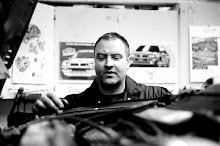I took the integrale with me, hopped on a North Sea ferry and met up with fellow Lancisti Michel Van Aggelen. Why? Because he's Dutch and I was in The Netherlands, he knows his country, integrales, suspension and is a friendly helpful kind of fella so was the best man for the job.

We made our way swiftly across the country, stopping briefly for a bite to eat and for Michel to take some pics of windmills.
We got to Intrax at about lunchtime, met up with 'Mr Intrax': Henk Thuis, discussed what we needed and what they could provide.

Henk has been racing some serious cars since 1993, Donkervoort, Alfa, BMW and currently a Porsche 996 which he won with in 2008, came runner up in 2009 and is currently doing well with in 2010.

After a quick tour of their premises which had some interesting Automotive machinery lurking in every corner (and large trophy cabinet)

I left the 'grale with them and it was back across the country in Michels 8v (well, you can't have everything) to a bar for a few beers before getting back onto the Ferry.
A few weeks later I was back to pick the car up, the guys there explained what they had done and Henk took me out for a drive, the car felt really tight and quick as he threw it around a local industrial estate.
The set up looks great, really well made and thought out:


We had some lunch and met up with another local Deltisti Bas Van Elten, I've been in contact with these guys for years via email so it was great to meet them in the flesh and have a good chat before heading off back to the ferry.
Back home and on track the grip is amazing, I met up with two customers, both 'grale drivers who could not get over how easy it was to corner at such high speeds, also with the addition of the thicker adjustable rear ARB set to 'dry' it changes direction through the tight left right flicks such as chicanes with superb composure.
A big thanks to Intrax and Michel, a big thumbs down to tightwads North Sea Ferries, Hull: If you want to go with a car and come back on foot they charge a very large premium, so I booked for a car both ways. On coming back with no car on the Dutch side it was no problem, I just showed my ticket, passport and walked on.
Trying to do the same on the UK side had me being pulled up at the check in desk and forced to pay a stupid amount of money to get on as a foot passenger.
Yes, you read that right, if you want to go on as a foot passenger and not take your car you are charged more!
Castor and camber

The Intrax strut top is available in different colours and is adjustable for camber and castor.
It's very difficult to find anything written about castor angles, I have several books on suspension and I think only one mentions why it can be important, advantageous and linked to camber.
Castor angle is the angle of the strut as viewed from the side:

Most people refer to it in connection with the directional stability of a car because this is its primary function, when you have more positive castor (viewed from the side, the top of the strut is further towards the back of the car) the steering self centres easier and the car is more stable in a straight line at high speed, the steering also becomes more heavy the more positive castor is applied.
This is Camber:

If the wheel leans in towards the car at the top then this is 'Negative camber'.
Basically, in order for the tyre to grip when cornering hard it needs to present itself flat to the tarmac so all of the surface of the tyre is working, camber gives us this. This is called 'Static camber' and whilst it comes into its own when cornering, it can be a compromise when braking or accelerating in a straight line when the tyre is at an angle to the road or track, both for traction and for tyre wear.
This is where positive castor angle (PCA) comes in and here is how it works:
The pencil is the strut with zero castor angle, the wheel (roll of tape) has zero camber angle, when we turn the 'wheel' it keeps the same angle, i.e, the tyre to road angle doesn't alter.


Now let's dial in some PCA:

The axis of the turned wheel has now altered and you see how it has affected the camber angle:

This is quite an exaggerated example, but it shows what is happening - the more you turn the wheel, the more camber is introduced.







































